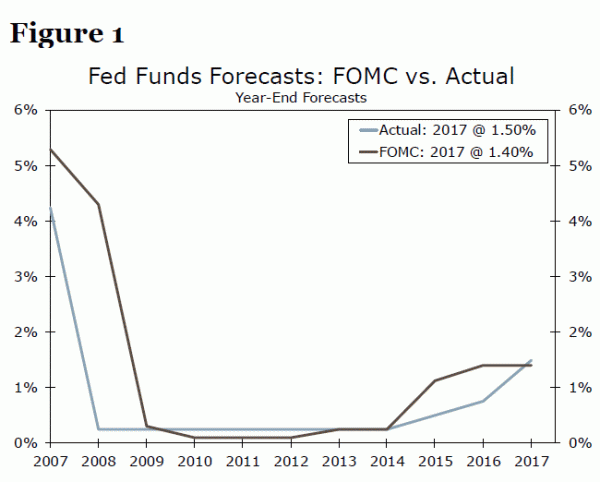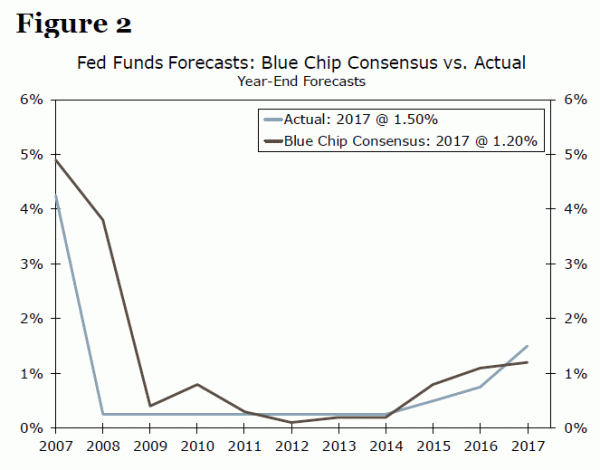“Prophesy is a good line of business, but it is full of risks.” – Mark Twain
Executive Summary
In our previous reports, we developed a framework to analyze FOMC and private sector forecast behavior, and our analysis suggested that the FOMC is overly optimistic.1 That is, the FOMC paints a positive picture by forecasting trend-like growth and a “controlled” inflation outlook. Our final report of this series examines whether FOMC and private sector growth and inflation forecasts are consistent with the corresponding fed funds rate forecasts.
Our analysis suggests that the FOMC under-forecasted the fed funds rate, while the Blue Chip consensus, a proxy for private sector forecast behavior, over-forecasted the fed funds rate for the complete time period. Under Fed Chair Bernanke’s leadership, the FOMC under-forecasted the fed funds rate, while the Blue Chip consensus over-forecasted the fed funds rate for the same period. But under Chair Yellen, the FOMC over-forecasted the fed funds rate, while the Blue Chip consensus continued to over-forecast the fed funds rate for the same period.
At first glance, the Blue Chip consensus’ forecasting behavior seems “consistent,” as overforecasting the fed funds rate is consistent with over-forecasting GDP growth. In theory, a stronger growth outlook would suggest a higher fed funds rate, all else equal. The same theoretical standards would characterize the FOMC’s forecasting behavior as “inconsistent,” as the FOMC underforecasted the fed funds rate, but over-forecasted GDP growth for the same time period.
However, the FOMC and Blue Chip consensus forecasts seem to be consistent with their respective objectives. For example, the private sector’s objective likely includes informing decision makers about potential changes in the economic regime, such as rising borrowing costs. Moreover, the fed funds rate is an important element in determining borrowing costs, and a stronger growth outlook would boost borrowing costs, all else equal. Private sector forecasts could send signals about the potential for higher borrowing costs via over-forecasting the fed funds rate. The FOMC’s stronger GDP growth forecasts and under-forecasts of the fed funds rate are also likely consistent with the FOMC’s dual mandate of price stability and fostering maximum employment. That is, the FOMC could be forecasting an economic outlook consistent with its mandate, where the economy is growing close to its potential without excessive inflationary pressures, so the fed funds rate increases only gradually.
A Theoretical Framework for Examining Forecast Behavior
Our previous report presented a theoretical framework to evaluate FOMC and private sector forecasts to characterize whether the FOMC or the private sector is overly optimistic. In practice, forecasts do not always hit their targets, and this creates a higher possibility of forecast errors. The total cost (potential damages/losses) of forecast errors is labeled as the loss function. The forecast error can be divided into an under-forecast (the forecast is lower than the actual value) and an over-forecast (the forecast is higher than the actual value). The question then becomes whether the cost of under-forecasting is identical to the cost of over-forecasting, known as a symmetric loss function. If the cost of being wrong is not identical for under-/over-forecasts, this is called an asymmetric loss function. In the case of a symmetric loss function, a forecaster is indifferent between under- and over-forecasting. However, an asymmetric loss function has the potential to dictate a preference for forecast errors. If a forecaster knows that under-forecasting could cause more damage than over-forecasting, that forecaster may tend to over-forecast, all else constant. We suggested that the loss function is asymmetric for both the FOMC and for the private sector. We now examine possible forecasting rationales for the Blue Chip consensus and the FOMC in terms of the fed funds rate forecasts.
Blue Chip consensus forecasts are a proxy for the private sector, and most of those forecasters and their firms would likely be affected by changing borrowing costs. In theory, a rising fed funds rate would increase borrowing costs for the private sector, and to gauge the borrowing cost trajectory, forecasters could send signals about the potential path of the fed funds rate. For example, a stronger growth outlook along with rising inflation would suggest a rising interest rate environment, all else equal, so over-forecasting GDP growth and inflation would be consistent with over-forecasting the fed funds rate. Most Blue Chip members’ forecasts also likely do not have the same type of explicit goal as the FOMC’s dual mandate, or the potential to influence expectations to the same degree as the FOMC.
The FOMC, however, has an explicit dual mandate, and its forecasts may also influence private sector forecasts2. Our previous reports concluded that the FOMC paints an optimistic picture through its GDP growth and inflation forecasts. In addition, the FOMC could influence private sector expectations via its fed funds rate forecast, as the forecast would indicate the expected policy stance. That is, a lower fed funds rate path may suggest an accommodative monetary policy stance, compared to a rising fed funds forecast that would indicate policy normalization or a restrictive policy stance, all else equal. In this way, the FOMC’s fed funds forecasts have a different objective than the private sector in terms of setting monetary policy, whereas the private sector responds to these policy changes.
Fed Funds Forecasts: The FOMC vs. the Blue Chip Consensus
We examine 10 years of historical fed funds rate forecast data from both the FOMC and the private sector, using the Blue Chip consensus as a proxy for private sector expectations. We compare the year-ahead fed fund forecast for each source to the actual year-end fed funds rate.3 While we only have limited readily available forecast data back to 2006, we find that for the entire forecast period, the FOMC under-forecasts the fed funds rate 55% of the time, while the Blue Chip consensus over-forecasts the fed funds rate 64% of the time. When we break out forecasts by Fed chair, we find a similar story for the Bernanke era, as the FOMC under-forecasted the fed funds rate 63% of the time, while the Blue Chip consensus over-forecasted the fed funds rate 63% of the time. Moving to the Yellen era, the trend reverses for the FOMC, as it over-forecasts the fed funds rate 67% of the time. The Blue Chip consensus maintains its forecast consistency over the same time period, also over-forecasting the fed funds rate 67% of the time.
Fed Funds vs. GDP and Inflation: Not All Forecasts are Created Equal
In our view, the fed funds rate forecasts may also carry a higher weight than growth and inflation forecasts. The GDP growth and inflation forecasts represent the FOMC’s expectations about the near-term economic outlook. The growth and inflation outlook is an integral element of rate-setting decisions; however, it is likely not the only aspect that influences these decisions. The FOMC has mentioned several times in its policy statements that financial sector developments, fiscal policy and international events are also part of the process when setting the fed funds rate target. Essentially, the fed funds rate forecast could shed light on the FOMC’s expectations about the near-term overall outlook, encompassing not only domestic economic factors, but also political and international events as well. Finally, the fed funds rate is arguably the most visible of these forecasts, giving it additional consideration in the policymaking process.
Conclusion: Power of Positive Thinking Does Matter in Policymaking
In our final report, we find that the FOMC tended to under-forecast the fed funds rate for the complete forecast period, while private sector forecasts measured by the Blue Chip consensus tended to over-forecast the fed funds rate. These differences likely stem from differing forecast objectives, as the FOMC likely focuses on its dual mandate and overall visibility of its expected monetary policy stance. The private sector, on the other hand, is more directly affected by rising borrowing costs, and could use its over-forecasts of the fed funds rate to signal such an event. These differing forecast outcomes confirm that objectives matter when it comes to forecasting monetary policy and informing the business community of the possible effects of policy changes.
APPENDIX
Our analysis utilizes 10 years of historical fed funds forecast data from the Fed’s Greenbook forecasts/Summary of Economic Projections (SEP) and the Blue Chip Economic Forecasts. For the FOMC’s fed funds forecasts, as the FOMC did not begin publishing the SEP until 2012, we use the forecasts complied by the Fed staff in the Greenbook and given to the FOMC ahead of each meeting as a proxy for the FOMC’s forecasts from 2006-2012. For each year, we take the one-year ahead forecast measured as the Q4 average published in the December Greenbook/SEP of the prior year. For example, we use the December 2006 Greenbook to get the full-year 2007 forecast. Once the FOMC began publishing the SEP in 2012, we use the median year-ahead forecast from the December “Dot Plot,” which displays fed funds rate projections of FOMC members.
For the Blue Chip consensus data, we use the Blue Chip Financial Forecast publication, which includes an aggregate consensus forecast of the individual forecast submissions of leading forecasters.4 We take the one-year ahead forecast measured as the Q4 average for each variable that is published in the January Blue Chip Financial Forecast publication. Using the January publication allows for the most complete year-ahead forecast, because forecasters effectively do not have information on economic conditions for the current year when preparing to submit forecasts for a January release.
1 “Is the FOMC Overly-Optimistic?” Published on July 31, 2018. “Is the FOMC or the Private Sector More Optimistic?” Published on August 28, 2018.
2Romer, Christina, D., and David H. Romer. 2000. “Federal Reserve Information and the Behavior of Interest Rates.” American Economic Review, 90 (3): 429-457.
3For more details on our methodology, please see the Appendix.
4 https://lrus.wolterskluwer.com/store/product/blue-chip-financial-forecasts/















